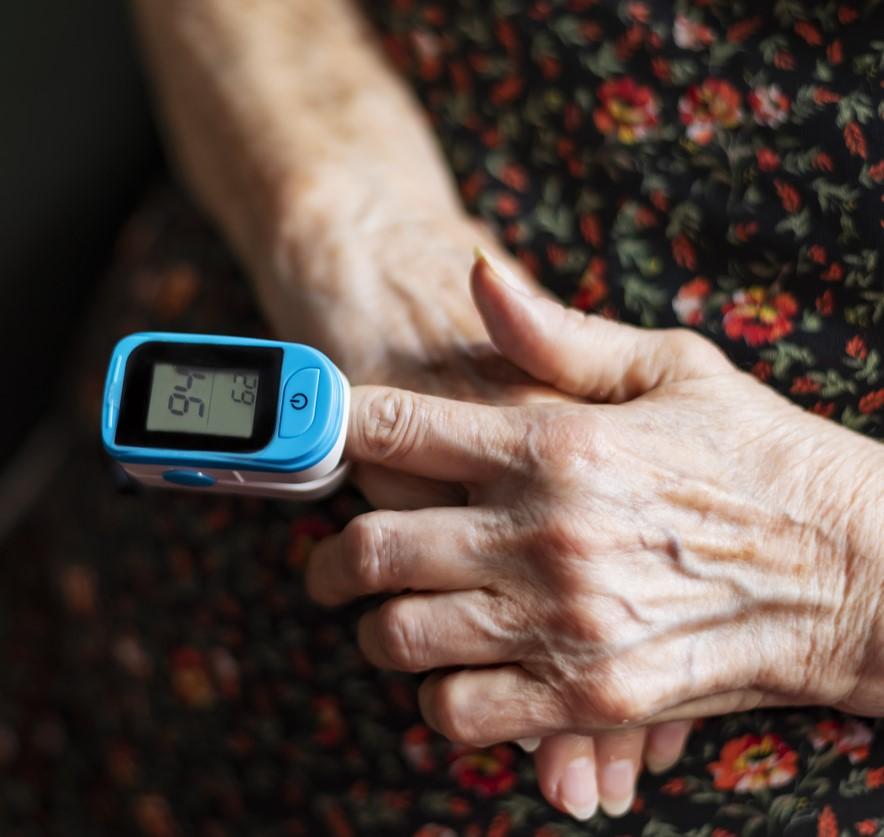A blood oxygen level below 92% and fast, shallow breathing were associated with significantly elevated death rates in a study of hospitalized COVID-19 patients, suggesting that people who test positive for the virus should watch for these signs at home, according to a study led by University of Washington at Seattle researchers.
The study, published today in Influenza and Other Respiratory Viruses, involved a chart review of 1,095 adult coronavirus patients hospitalized at University of Washington hospitals or Rush University Medical Center in Chicago from Mar 1 to Jun 8, 2020.
Almost all patients with low oxygen levels (99%) and rapid breathing (98%) were given supplemental oxygen and glucocorticoids to quell inflammation.
Few cases of shortness of breath, cough
Of the 1,095 patients, 197 (18%) died in the hospital. Relative to those hospitalized with normal blood oxygen saturations, those with low levels were 1.8 to 4.0 times more likely to die in the hospital. Likewise, patients with high respiration rates were 1.9 to 3.2 times more likely to die than those with normal rates.
Few patients reported shortness of breath (10%) or cough (25%), even if their blood oxygen levels were 91% or lower or they were taking 23 or more breaths per minute. "In our study, only 10% of hospitalized patients reported shortness of breath, and admission respiratory symptoms were not associated with hypoxemia [low blood oxygen] or mortality, underscoring that respiratory symptoms are uncommon and by themselves may not accurately identify at-risk patients," the authors wrote, adding that delays in recognition could lead to poor outcomes.
Higher body mass index was linked with both lower oxygen levels and faster respiratory rate. Body temperature, heart rate, and blood pressure weren't associated with death.
The most common symptom at hospital admission was fever (73%). Mean patient age was 58, 62% were men, and many had underlying illnesses such as high blood pressure (54%), diabetes (33%), coronary artery disease (12%), and heart failure (12%).
Indicators could guide patients in seeking care
"These findings apply to the lived experience of the majority of patients with COVID-19: being at home, feeling anxious, wondering how to know whether their illness will progress and wondering when it makes sense to go to the hospital," co-lead author Neal Chatterjee, MD, said in a University of Washington news release
The authors said that the findings suggest that even asymptomatic people who test positive for COVID-19 and are at high risk for poor outcomes owing to advanced age or obesity should count their breaths per minute and obtain a pulse oximeter to measure their blood-oxygen concentrations at home, the study authors said. Pulse oximeters, they said, clip on to a fingertip and can sell for less than $20. But even without a pulse oximeter, fast breathing rates can serve as a marker of respiratory distress.
"An even simpler measure is respiratory rate—how many breaths you take in a minute," co-lead author Nona Sotoodehnia, MD, MPH, said in the release. "Ask a friend or family member to monitor you for a minute while you're not paying attention to your breathing, and if you hit 23 breaths per minute, you should contact your physician."
Sotoodehnia pointed out that glucocorticoids and supplemental oxygen can benefit COVID-19 patients. "We give supplemental oxygen to patients to maintain blood oxygen saturation of 92% to 96%," she said. "It's important to note that only patients on supplemental oxygen benefit from the life-saving effects of glucocorticoids."
The researchers also called for revision of the Centers for Disease Control and Prevention (CDC) and World Health Organization (WHO) COVID-19 guidelines, which recommend that coronavirus patients seek medical care when they have overt symptoms such as "trouble breathing" and "persistent pain or pressure in the chest."
Patients might not experience these symptoms, even when breathing rates are fast and blood oxygen levels have dropped to dangerous levels. This guidance would be particularly important for first-line clinical contacts such as family practice doctors and telehealth providers.
"We recommend that the CDC and WHO consider recasting their guidelines to account for this population of asymptomatic people who actually merit hospital admission and care," Chatterjee said. "But people don't walk around knowing WHO and CDC guidelines; we get this guidance from our physicians and news stories."


















